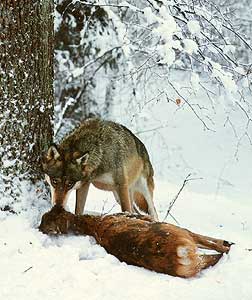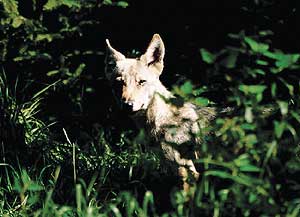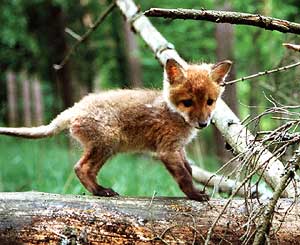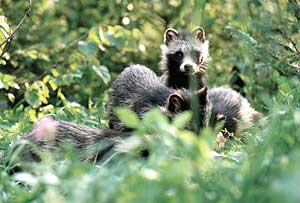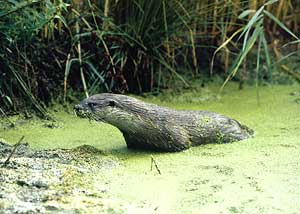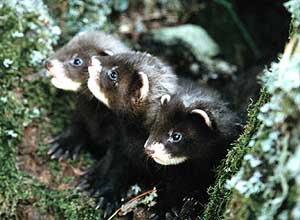| MAMMALS
| ||||||||||||||
Text:
|
Carnivores Carnivora
Carnivores include species whose main diet consists of fresh meat and carcasses. Their teeth are adapted to such food: most species have large, sharp and slightly bent canine teeth (fangs) and strongly developed carnassials, called the flesh teeth (the last upper premolar tooth and first lower molar tooth). Numerous offspring is typical of predators. The cubs grow slowly and they remain under parents' care a relatively long time.
Until recently predators were seen as possible hunting competitors, a nuisance in game management. However, ecological studies have proved that they are an important part of ecosystems, not only a factor affecting biological equilibrium but also contributing to the eradication of focal outbreaks of epidemic diseases.
Amongst all carnivores the wolf (Canis lupus) is the best-known species. It lives gregariously in families. There is a complex social hierarchy within the wolf pack, with a dominant pair, usually being the only one in the pack, engaging in reproduction. It is the dominant female wolf that selects the place where the cubs will be born. In early spring, after 62-64 days of gestation, she-wolf gives birth to the cubs in a den or under a safe, dry wind-fallen tree. After several weeks, when cubs start eating meat, all the activity of the pack concentrates on providing food to the mother and the quickly growing cubs. Some wolves from the pack show special dedication and they almost ”nurse” the cubs and stay with them when parents are away hunting. The utmost care of such ”aunts” and ”uncles” gives the cubs higher chances to survive the first, most critical year.
All the family pack occupies its own, fairly a permanent territory and defends the territorial boundaries against other packs. Wolves usually hunt as a whole pack, using various methods, from individual attacks to group encircling of the prey. The most common prey are wild ungulates: roe deer, red deer and boars, while hares, small predators (foxes, racoon dogs, martens), rodents, reptiles amphibians, insects and plant food are only small supplements to the diet. The wolves are also attracted to carrion. Apart from sporadic cases of attacks against deer, no significant impact of the wolf on the numbers of other animals was recorded in the Wigry National Park. Beavers are the only exception as whole beaver families can be hunted by wolves. The density of the beaver population is very high and hence this rodent is an increasingly frequent element of the wolves’ diet.
The fox (Vulpes vulpes) is the most common canine mammal in Poland. Thanks to its well-developed senses, above all hearing, it is considered an extremely cunning and intelligent animal. It hears a mouse’s squeak at a distance of 100 metres. Due to its ability to adjust to various living conditions it can live in a variety of habitats. It lives mainly in forests, but it also occurs in fields, meadows and on the banks of reservoirs. The fox has no aversion to living in the vicinity of human settlements. The fox is one of the most popular fur animals, but the low interest of hunters in this species has led to local overdensity in some regions in recent years. It is immediately reflected in the decrease of the population of small animals, including the hare and partridge which are constituents of the foxes’ diet. This also includes beetles, amphibians, rodents, birds, hares and young deer. It also feeds on carrion and plants. Foxes live in burrows with several exits and a nest chamber. Sometimes foxes share their burrows peaceably with badgers. The fox is a species often infected with rabies and is a vector of this disease.
The racoon dog (Nyctereutes procyonoides) is a somewhat smaller relative of the fox. This member of the dog family was introduced artificially: it came from Asia to the European part of the Soviet Union and in the 1950s it entered Poland as a result of natural migration. At present it is a permanent element of the fauna of Central Europe. The racoon dog lives in various types of forest, including shrubs. Preferably, it settles near bodies of water. It uses fox or badger burrows for breeding and bringing the young and as sites for wintering. If it cannot find a free burrow, it digs one on its own. Most active at night, it loiters to find food. It is omnivorous, feeds on rodents, birds, eggs, amphibians and bulb roots. Due to its nocturnal activity its smell and hearing are the most developed senses, but has fairly poor sight. It is the only member of the canine family to hibernate in winter.
The otter (Lutra lutra) is a representative of the Mustelidae family, living on the banks of water bodies in the Wigry National Park. The short-legged otter moves relatively slowly on land, but is a fast and agile swimmer. Its whole anatomy is adapted to living in water. The digits of fore and hind limbs are joined by a web. A small head with a short muzzle, small eyes and ears, short neck, oval body and slightly flattened body enable the otter to move in an aquatic habitat with thick vegetation. The otter remain submerged in water up to 8 minutes: this capability is especially useful in winter. Then, it dives under the ice in the search of an air hole where it breathes and next again dives in water. It swims very fast in water, and due to which it can overtake fish, which are its main food. Crayfish, fogs, molluscs, water insects and water birds as well their eggs are another source of food: otters also feed, less frequently, on rodents and vegetation.
The European polecat (Mustela putorius) is a typical nocturnal predator. Having slept a day in shelter, it goes hunting at night, feeding mainly on amphibians, rodents, birds, snails and insects. If it hunts near human settlements, it may inflict some damage to fowls. These losses are offset by the fact that polecats hunt rodents. When attacked, the polecat defends itself by excreting an unpleasant odour from glands located near the tail. The scent is also used by polecats to mark their territory. In Poland it is common and it is legitimate game for hunting.
| |||||||||||||
|
|
